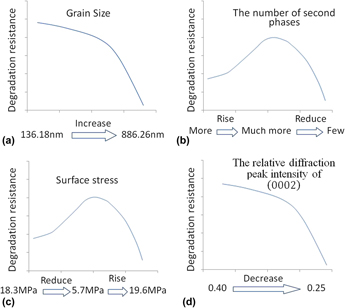Crossref Citations
This article has been cited by the following publications. This list is generated based on data provided by
Crossref.
Zhao, Yanchun
Zhang, Hua
Fan, Jianfeng
Wang, Lifei
Zhang, Qiang
Peng, Cheng
Dong, Hongbiao
and
Xu, Bingshe
2018.
Grain refining and improving mechanical properties of AZ31 Mg alloy sheets by multi-pass warm rolling with falling temperature.
Journal of Materials Research,
Vol. 33,
Issue. 18,
p.
2827.
Qi, Jiqiang
Du, Yuzhou
Jiang, Bailing
and
Shen, Mingjie
2018.
Hot deformation behavior and microstructural evolution of Mg–Zn–Ca–La alloys.
Journal of Materials Research,
Vol. 33,
Issue. 18,
p.
2817.
de Castro, Moara M.
Carvalho, Amanda Pereira
Pereira, Pedro Henrique R.
Isaac Neta, Augusta C.
Figueiredo, Roberto B.
and
Langdon, Terence G.
2018.
Consolidation of Magnesium and Magnesium Alloy Machine Chips Using High-Pressure Torsion.
Materials Science Forum,
Vol. 941,
Issue. ,
p.
851.
Silva, Claudio L. P.
Soares, Renata B.
Pereira, Pedro Henrique R.
Figueiredo, Roberto B.
Lins, Vanessa F. C.
and
Langdon, Terence G.
2019.
The Effect of High‐Pressure Torsion on Microstructure, Hardness and Corrosion Behavior for Pure Magnesium and Different Magnesium Alloys.
Advanced Engineering Materials,
Vol. 21,
Issue. 3,
Mukaeva, V R
Kulyasova, O B
Farrakhov, R G
and
Parfenov, E V
2019.
Mechanical properties and corrosion behavior of Mg-1Zn-0.2Ca alloy with various grain size.
IOP Conference Series: Materials Science and Engineering,
Vol. 479,
Issue. ,
p.
012075.
Castro, Moara
Pereira, Pedro Henrique
Figueiredo, Roberto
and
Langdon, Terence
2019.
Developing magnesium-based composites through high-pressure torsion.
Letters on Materials,
Vol. 9,
Issue. 4s,
p.
541.
Li, Qite
Ye, Wenbo
Gao, Hong
and
Gao, Lilan
2019.
Improving the corrosion resistance of ZEK100 magnesium alloy by combining high-pressure torsion technology with hydroxyapatite coating.
Materials & Design,
Vol. 181,
Issue. ,
p.
107933.
Figueiredo, Roberto B.
and
Langdon, Terence G.
2019.
Processing Magnesium and Its Alloys by High‐Pressure Torsion: An Overview.
Advanced Engineering Materials,
Vol. 21,
Issue. 1,
Kurniawan, K. A.
Wicaksono, S. T.
Rasyida, A.
and
Purniawan, A.
2019.
Improvement of compressive strength of Mg-Fe-Ca alloy by heat treatment as biodegradable implant.
Vol. 2202,
Issue. ,
p.
020054.
Kaviani, M.
Ebrahimi, G.R.
and
Ezatpour, H.R.
2019.
Improving the mechanical properties and biocorrosion resistance of extruded Mg-Zn-Ca-Mn alloy through hot deformation.
Materials Chemistry and Physics,
Vol. 234,
Issue. ,
p.
245.
Sorkhi, Leila
Hammell, Joshua J.
and
Crawford, Grant A.
2020.
Effect of Interlayer Interval Time on the Microstructure and Mechanical Behavior of Additively Manufactured WE43 Mg Alloy.
Metallurgical and Materials Transactions A,
Vol. 51,
Issue. 9,
p.
4390.
Lopes, Debora
Soares, Renata B.
Castro, Moara M.
Figueiredo, Roberto B.
Langdon, Terence G.
and
Lins, Vanessa F. C.
2020.
Corrosion Behavior in Hank's Solution of a Magnesium–Hydroxyapatite Composite Processed by High‐Pressure Torsion.
Advanced Engineering Materials,
Vol. 22,
Issue. 12,
Wang, Tianfang
Ni, Guoying
Furushima, Tsuyoshi
Diao, Hui
Zhang, Pingping
Chen, Shu
Fogarty, Conor E.
Jiang, Zhengyi
Liu, Xiaosong
and
Li, Hejie
2021.
Mg alloy surface immobilised with caerin peptides acquires enhanced antibacterial ability and putatively improved corrosion resistance.
Materials Science and Engineering: C,
Vol. 121,
Issue. ,
p.
111819.
Chen, Bi
Wang, Dongxin
Zhang, Lei
Geng, Guihong
Yan, Zhijie
and
Eckert, Jürgen
2021.
Correlation between the crystallized structure of Mg67Zn28Ca5 amorphous alloy and the corrosion behavior in simulated body fluid.
Journal of Non-Crystalline Solids,
Vol. 553,
Issue. ,
p.
120473.
Li, Huafang
Wang, Pengyu
and
Wen, Cuie
2022.
Recent Progress on Nanocrystalline Metallic Materials for Biomedical Applications.
Nanomaterials,
Vol. 12,
Issue. 12,
p.
2111.
Kulyasova, Olga B.
Khudododova, Ganjina D.
Dyakonov, Grigory S.
Zheng, Yufeng
and
Valiev, Ruslan Z.
2022.
Effect of Microstructure Refinement on the Corrosion Behavior of the Bioresorbable Mg-1Zn-0.2Ca and Mg-1Ca Alloys.
Materials,
Vol. 15,
Issue. 19,
p.
6749.
Bahmani, Ahmad
Lotfpour, Mehrab
Taghizadeh, Milad
and
Kim, Woo-Jin
2022.
Corrosion behavior of severely plastically deformed Mg and Mg alloys.
Journal of Magnesium and Alloys,
Vol. 10,
Issue. 10,
p.
2607.
Zhang, Congzheng
Liang, Chen
Liang, Ting
Si, Xinyu
and
Jiang, Chunqiang
2022.
Enhanced mechanical properties of an Mg-Zn-Ca alloy via high pressure torsion and annealing for use in bone implantation.
Matéria (Rio de Janeiro),
Vol. 27,
Issue. 3,
Khani, Masood
Ebrahimi, Gholamreza
and
Ezatpour, Hamidreza
2022.
Accumulative extrusion bonding of Mg-Mn-Ca/FA+GNP hybrid biocomposite: On microstructure evaluation, mechanical and corrosion properties.
Materials Today Communications,
Vol. 33,
Issue. ,
p.
104426.
Marques de Castro, Moara
Ribeiro Lopes, Débora
and
Viana Dias, Leonardo
2022.
Magnesium Alloys Structure and Properties.






